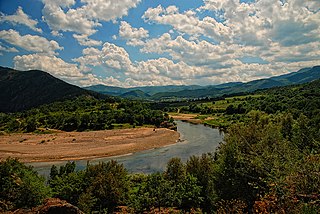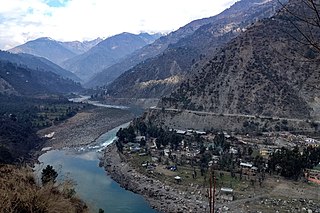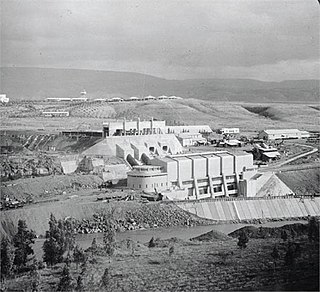
The Zeta is a river in Montenegro.

The Beas River is a river in north India. The river rises in the Himalayas in central Himachal Pradesh, India, and flows for some 470 kilometres (290 mi) to the Sutlej River in the Indian state of Punjab. Its total length is 470 kilometres (290 mi) and its drainage basin is 20,303 square kilometres (7,839 sq mi) large.

The Dnieper, also called Dnipro, is one of the major transboundary rivers of Europe, rising in the Valdai Hills near Smolensk, Russia, before flowing through Belarus and Ukraine to the Black Sea. Approximately 2,200 km (1,400 mi) long, with a drainage basin of 504,000 square kilometres (195,000 sq mi), it is the longest river of Ukraine and Belarus and the fourth-longest river in Europe, after the Volga, Danube, and Ural rivers.

The Arda is a 290-kilometre-long (180 mi) river in Bulgaria and Greece. It is a tributary of the Maritsa. Its source lies in the Bulgarian Rhodope Mountains near the village Arda, part of the municipality of Smolyan. It flows eastward past Rudozem, Kardzhali and Ivaylovgrad and enters Greece in the northern part of the Evros regional unit. It flows into the Maritsa on the border of Greece and Turkey, between the Greek village Kastanies and the Turkish city Edirne. In the Bulgarian section there are three hydroelectric and irrigation dams, Kardzhali Dam, Studen Kladenets and Ivaylovgrad Dam. The Bulgarian section is 229 kilometres (142 mi) long, making the Arda the longest river in the Rhodopes. The medieval Dyavolski most arch bridge crosses the river 10 kilometres (6 mi) from Ardino.

The Neretva, also known as Narenta, is one of the largest rivers of the eastern part of the Adriatic basin. Four hydroelectric power plants with large dams provide flood protection, power and water storage. It is recognized for its natural environment and diverse landscapes.

The Jhelum River (/dʒʰeːləm/) is a river in the northern Indian subcontinent. It originates at Verinag and flows through the Indian-administered territory of Jammu and Kashmir, into Pakistani-administered Azad Kashmir, then the Pakistani province of Punjab. It is the westernmost of the five rivers of the Punjab region, and flows through the Kashmir Valley. It is a tributary of the Chenab River and has a total length of about 725 kilometres (450 mi).

The Chenab River is a major river that flows in India and Pakistan, and is one of the 5 major rivers of the Punjab region. It is formed by the union of two headwaters, Chandra and Bhaga, which rise in the upper Himalayas in the Lahaul region of Himachal Pradesh, India. The Chenab flows through the Jammu region of Jammu and Kashmir, India into the plains of Punjab, Pakistan, before ultimately flowing into the Indus River.

The Thyamis, also known as Glykys (Γλυκύς) or Kalamas (Καλαμάς), is a river in the Epirus region of Greece. It flows into the Ionian Sea. It is 115 km (71 mi) long, and its drainage area is about 1,800 km2 (690 sq mi), over 99% of which on Greek territory. The names of the Chameria region, as well as the Chams, derive from the river's name.
In Greek mythology, Anapus was god of the river Anapus in eastern Sicily. He was worshiped by the Syracusans, who depicted him as a young man. Anapus was husband to the naiad Cyane, who attempted to dissuade Hades from abducting Persephone, describing how she consented to Anapus' wooing out of love, rather than force.

The Necropolis of Pantalica is a collection of cemeteries with rock-cut chamber tombs in southeast Sicily, Italy. Dating from the 13th to the 7th centuries BC, there was thought to be over 5,000 tombs, although the most recent estimate suggests a figure of just under 4,000. They extend around the flanks of a large promontory located at the junction of the Anapo river with its tributary, the Calcinara, about 23 km (14 mi) northwest of Syracuse. Together with the city of Syracuse, Pantalica was listed as a UNESCO World Heritage Site in 2005.
Solarino is a comune (municipality) in the Province of Syracuse, Sicily (Italy). It is about 190 kilometres (120 mi) southeast of Palermo and about 15 kilometres (9 mi) west of Syracuse. As of 31 December 2006, it had a population of 7,365 and an area of 13.01 square kilometres (5.02 sq mi).

The Voghji or Okchuchay is a river on the south slopes of the Lesser Caucasus range, and is a left tributary of Aras. It flows through the territory of Armenia and Azerbaijan.

The Ciane is a short river in southern Sicily, Italy. It flows into the Ionian Sea near Syracuse, after a run of 8 kilometres (5 mi), at a common mouth with the Anapo.

Mount Lauro is a mountain reaching 986 metres located in south-eastern Sicily belonging to the chain of Hyblaean Mountains, stretching between the three provinces of Catania, Ragusa and Siracusa. Monte Lauro is part of a complex of extinct volcanoes having formed under the sea during the Miocene epoch.

Monte Casale is a mountainous elevation on Sicily in Italy, reaching 910m above sea level, which formed part of the oldest volcanic formation of the Hyblaean Mountains. Their peaks form the boundary between the present-day provinces of Syracuse and Ragusa and the watershed between the Irminio and Anapo rivers. It is notable for its important archaeological remains, discovered by Paolo Orsi early in the 20th century and identified by him with the ancient Greek city of Casmene.

Rama is a river in Bosnia and Herzegovina, and a major tributary of the Neretva. It joins it from the right by discharging into Neretva's artificial reservoir, Jablaničko lake, at place called Marina Pećina, near village of Gračac, between location of underground powerhouse of Rama Hydroelectric Power Station and Jablanica Dam, depending on water level in Jablaničko lake, some 15 kilometers upstream from Jablanica.

Bistrica is sinking river near Livno in Western Bosnia, Bosnia and Herzegovina, though highly regulated for hydropower and irrigation since mid-20th century.

Trebinje I Hydroelectric Power Station or Trebinje-1 Hydroelectric Power Station is hydroelectric power plant (HPP) on the Trebišnjica River near Gornje Grančarevo in the municipality of Trebinje in Bosnia and Herzegovina. Trebinje-1 HPP is accumulation with dam toe powerhouse type of facility with a large Grančarevo arch dam. At the height of 123 m (404 ft), Grančarevo dam is the tallest dam in the country. Its reservoir, Bileća Lake, is the largest by volume in Bosnia and Herzegovina as well. The dam provides for flood control and hydroelectric power generation at Trebinje-1 HPP. The dam was completed in 1967 and its 180 MW power station, A smaller 8 MW power station, Treblinje-2, was completed downstream in 1979.

Cava del Rivettazzo is a Sicel necropolis located about 4 km north of Solarino on the SP 28 to Sortino.





















